
A meaningful form of on-site inventory assessment
Configuration Management
Configuration Management/ On-Site Assessment
Configuration Management is a management activity that provides technical and administrative direction over the entire product lifecycle, covering the configuration units of the product and product configuration-related information.
In principle, Configuration Management helps system operators and maintenance personnel maintain oversight of which manufacturers supply which units, in what quantities and versions, and in which machines or systems they are used, as well as under operating conditions.
Despite continuously shorter innovation cycles in the field of electronic assemblies and the resulting component obsolescence, the planned service life of industrial machinery and equipment continues to increase. Among our clients, operational lifespans of 20 to 30 years are by no means uncommon. Frequently, internal company knowledge becomes obsolete faster than machines and systems are modified. This makes it all the more important to maintain proper documentation throughout the entire product lifecycle.
However, this is precisely where we encounter various challenges. The most striking problems are time and resource constraints, which are unfortunately all too common in maintenance departments. As a result, the scope of tasks is much broader than it may initially appear.
Upon request, we will be happy to carry out a comprehensive on-site Configuration Management process.
Data types should be current, structured, complete, and plausible.
Data types should be current, structured, complete, and plausible
Many complex tasks can be associated with Configuration Management, but the first step is often not the perfect solution for all of your master data issues. The initial step is to work with you to establish a solid data foundation, based on which we can jointly embark on a Life Cycle Management project. Through on-site inventory assessment, we can collect all the necessary data for you and continue this process if needed. In this context, we differentiate between core data, which is essential, individual data, and environmental data, which can be collected additionally to complete your data foundation:




